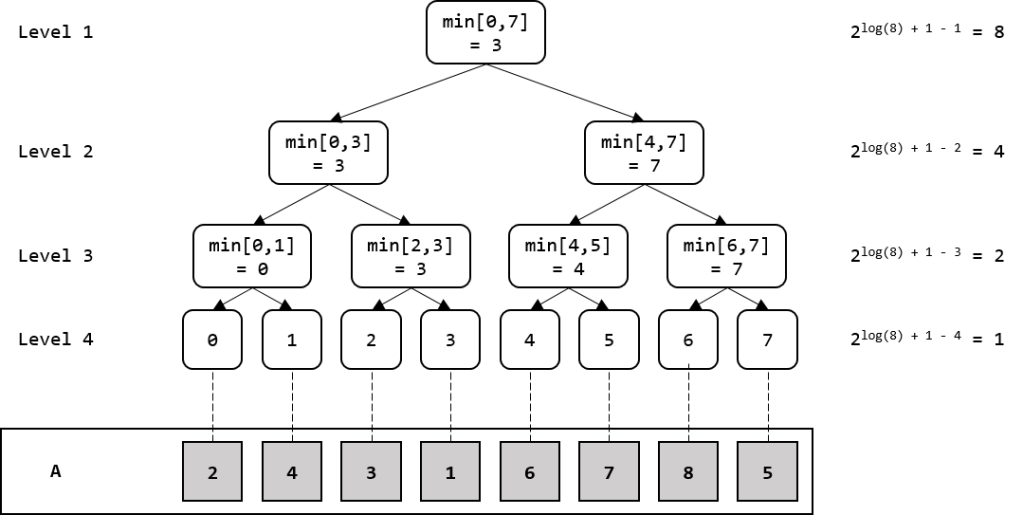Range Minimum Query
Given an array of length
, answer
qeuries.
should return the index
, where
.
There are many ways to do this. In the case where 's element values are allowed to change, and yet we have to maintain
to work correctly, a segment tree is our best option. Follows is a brief explanation of segment trees for this specific example. I'll put a more generalized explanation in another post.
Segment Trees
The idea behind a segment tree is to build a binary tree where each node represents a segment of . For Range Minimum Query, each tree node will contain the value of
(the index of the minimum value in the node’s segment of the array).
Now, how are nodes and segments assigned? For simplicity, let’s assume that ‘s length is a power of two:
- Starting at the lowest level of the tree, we’ll have
leaf nodes each representing an element of
. As shown in the following figure, if we label leaf nodes from
to
from left to right, each node
will contain the value
.
- For each internal node
starting from the bottom, we compute
as follows:
. Meaning, a parent node
will get the value of one of its children such that
is minimum.
- Since this is a binary tree with the last level having
nodes, the tree will have the height of
. Level
will have one node, the root, which holds
. This means that each node on a level
will represent a segment of length
.
The implementation is going to be straight forward from here on. We’ll represent the tree as an array tree of length 2 << ceil(log2(N + 1)). Node i has a left child 2 * i and a right child 2 * i + 1. On an update(i), we’ll traverse the tree from top to bottom, change array value at when we reach the leaf i, and update the tree as we go back up. On a getMin(range), we’ll recurse from root until we visit all maximal sub-segments of the range and return the required value. Here’s an implementation in C++ with this tutorial as a reference:
#include <iostream>
#include <vector>
#include <cstring>
#include <cmath>
using namespace std;
class segTree {
// O(n)
int *array, *tree;
int arrayLen, treeLen;
// O(n)
void initialize(int node, int b, int e) {
if (b == e)
tree[node] = b;
else {
// recurse
initialize(2 * node, b, (b + e) / 2);
initialize(2 * node + 1, (b + e) / 2 + 1, e);
// update value
if (array[tree[2 * node]] <= array[tree[2 * node + 1]])
tree[node] = tree[2 * node];
else
tree[node] = tree[2 * node + 1];
}
}
public:
segTree(int *array, int arrayLen) {
this->arrayLen = arrayLen;
this->array = array;
this->treeLen = 2 << (int)ceil(log2(arrayLen));
cout << "treeLen=" << treeLen << endl;
this->tree = new int[treeLen];
memset(tree, -1, sizeof(int) * treeLen);
initialize(1, 0, arrayLen - 1);
}
// O(log n)
void update(int i, int v, int node = 1, int b = 0, int e = 0) {
e = arrayLen - 1 - e;
if (b == e) {
array[i] = v;
} else {
int mid = (b + e) / 2;
if (i <= mid)
update(i, v, 2 * node, b, arrayLen - 1 - mid);
else
update(i, v, 2 * node + 1, mid + 1, arrayLen - 1 - e);
if (array[tree[2 * node]] <= array[tree[2 * node + 1]])
tree[node] = tree[2 * node];
else
tree[node] = tree[2 * node + 1];
}
}
// O(log n)
int query(int i, int j, int node = 1, int b = 0, int e = 0) {
e = arrayLen - 1 - e;
// bad interval
if (i > e || j < b)
return -1;
// good interval
if (b >= i && e <= j)
return tree[node];
// partial interval
int left = query(i, j, 2 * node, b, arrayLen - 1 - (b + e) / 2);
int right = query(i, j, 2 * node + 1, (b + e) / 2 + 1, arrayLen - 1 - e);
if (left == -1)
return tree[node] = right;
if (right == -1)
return tree[node] = left;
if (array[left] <= array[right])
return tree[node] = left;
return tree[node] = right;
}
};
int main() {
int A[10] = { 2, 4, 3, 1, 6, 7, 8, 9, 1, 7 };
segTree t(A, 10);
cout << "getMin(0, 4) = " << t.query(0, 4) << endl;
t.update(1, 0);
cout << "getMin(0, 4) = " << t.query(0, 4) << endl;
t.update(0, -1);
cout << "getMin(0, 4) = " << t.query(0, 4) << endl;
return 0;
}

